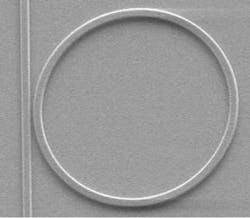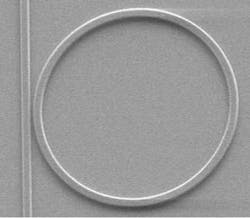Silicon chip controls light all-optically
While photonic structures that bend, split, couple, and filter light have been demonstrated in silicon, the light path in these structures has been predetermined and cannot be modulated during operation. To date, all-optical switching in silicon has only been possible by using extremely high optical powers in large or nonplanar structures. Based on their previous theoretical prediction that efficient optical switching in silicon could be achieved using resonant structures, Carlos Barrios, Michal Lipson, and their team at the School of Electrical and Computer Engineering at Cornell University (Ithaca, NY) have now fabricated such structures and demonstrated the capability.1
Modulating light using silicon structures is difficult because of the weak dependence of the refractive index and absorption coefficient on the free-carrier concentration. To overcome these difficulties, Lipson and his team proposed the use of highly confined resonant structures that enhance the effect of refractive-index change on the transmission response. The transmission of a ring resonator coupled to a waveguide is highly sensitive to the signal wavelength, and is greatly reduced at wavelengths at which the ring circumference corresponds to an integral number of guided wavelengths. The team fabricated a silicon-on-insulator ring resonator with a diameter of 10 μm using electron-beam lithography and inductively coupled plasma-reactive ion etching. Both the silicon waveguide and the ring resonator are channel waveguides with 450‑nm-wide and 250-nm-high rectangular cross sections (see figure).
Testing the structure
To test this structure, 10-ps pump pulses were used to inject free carriers through two-photon absorption inside the ring resonator, thereby tuning its effective refractive index. The probe and pump beam wavelengths were centered around two adjacent resonances of the ring resonator at 1535.6 and 1555.5 nm. The laser source for the pump was a tunable modelocked optical parametric oscillator (OPO), which in turn was pumped by a Ti:sapphire picosecond laser at a 78-MHz repetition rate. The OPO generates 1.5-ps pulses that pass through a Fabry-Perot tunable filter in order to produce the pump beam, which comprises 10-ps pulses with energy of less than 25 pJ coupled to the silicon waveguide input. A tunable continuous-wave laser provides the probe signal.
The pump and probe beams are coupled into the silicon waveguide by an external tapered, lensed fiber and an on-chip fiber-to-waveguide nanotaper coupler. The transmitted probe signal is coupled into a collimator and separated from the transmitted pump light through a band-pass tunable grating filter. The wavelength peak shift of the ring resonator near a resonance peak corresponds to an effective-index change of −4.8 × 10-4, or equivalently to a refractive-index change in the silicon core of -5.2 × 10-4.
The free-carrier concentration generated in the ring resonator is proportional to the square of the circulating pump power. The low losses due to probe absorption indicate that the observed modulation is due only to a refractive-index change; thermal effects can be neglected. In effect, the pump signal is used to alter the effective refractive index of the waveguide, thus either allowing or not allowing the data signal to be transmitted through the waveguide.
The demonstrated device could be used as a modulator, switch, or router, with a time response as low as 100 ps. When used as a router, an alternative geometry for the ring resonator would need to be used in which the ring is coupled to two waveguides. In this configuration, the incoming data and the control signal are coupled to the input port of the first waveguide (which contains the input port and the through port), whereas the signal output is routed to the second waveguide (the drop port). The device could switch incoming data to either the drop port or the through port, depending on the presence or absence respectively of a control pulse. For this application, the incoming data stream would be tuned to one of the microring resonances and a control signal tuned to an adjacent resonance, as was demonstrated.
The team is excited about the possibility of using these devices in true photonic circuits. “This is the first time photonic switching has been done in silicon in such compact structures,” said Michal Lipson, leader of the Cornell Nanophotonics Group. With the demonstration of the concept complete, the team now plans to concentrate on making devices with faster switching speeds and lower optical loss.
REFERENCE
1. V. R. Almeida et al., Nature 431, 1081 (Oct. 28, 2004).

